Day 3 of a three day Early Autumn Tour today, our last day. The wind had dropped after yesterday and after a cloudy start, there were lots of bright sunny intervals and it even warmed up nicely by the afternoon.
With a light easterly wind over southern Norway overnight, and northerlies still to bring birds in to the North Norfolk coast, we thought it worth a look to see if we could find any drift migrants carried across the North Sea. We headed down to Wells Woods first thing. There were several Little Grebes out on the boating lake as we walked in along the track. It sounded like they were laughing at us – did they know something we didn’t?
A Chiffchaff flitted ahead of us and perched in the top of a hawthorn and a Blackcap was hopping around in a dense patch of brambles, feeding on the berries. But both were more likely local birds than migrants. As we walked into the birches it seemed rather quiet, there were just a few Coal Tits calling from the trees. We walked round the Dell, hoping to run into one of the tit flocks, but there was nothing here.We stopped to watch a pair of Great Spotted Woodpeckers high in the pines.
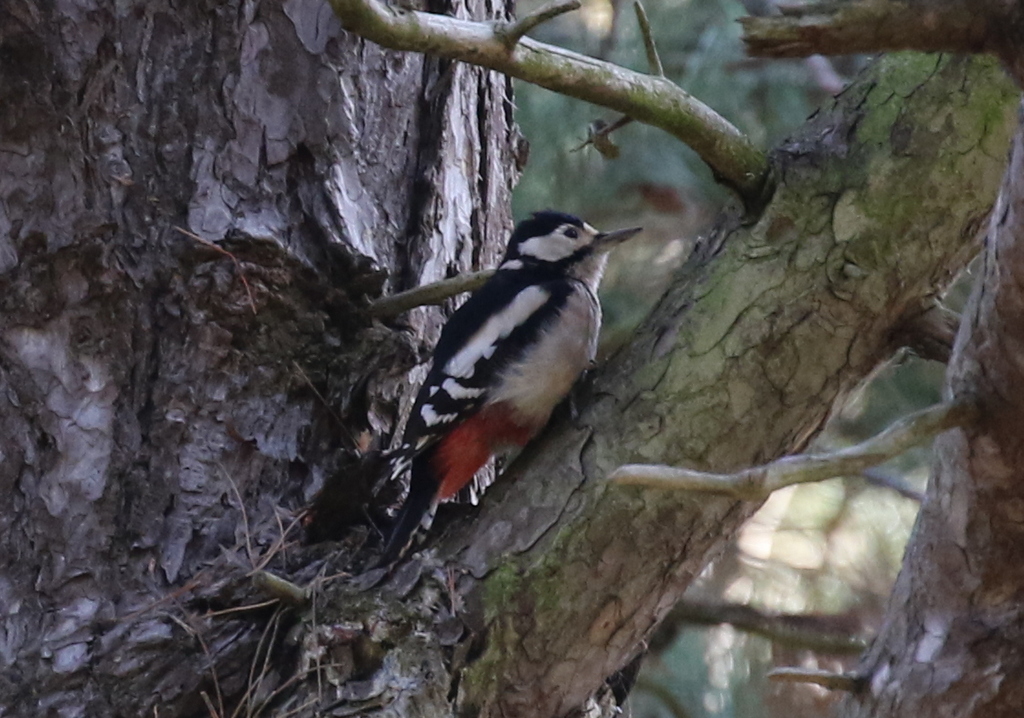
So we changed tack and walked across the main track to check out the bushes the other side. There were a couple of Greenfinches in the trees, a Jay appeared briefly in a pine and a couple of Muntjacs were out on the grazing marshes beyond. Not what we were hoping to find. As we walked back through the birches, we heard the yelping calls of a flock of Pink-footed Geese flying over behind us.
We walked back along the main track but thought we would cut through round the east side of the Dell just in case we could find a tit flock here. There were just a couple of Chiffchaff and Blackcap calling at first, but when we got back to the birches by the toilet block we could hear Long-tailed Tits calling. Suddenly we were surrounded by so many birds, we didn’t know where to look!
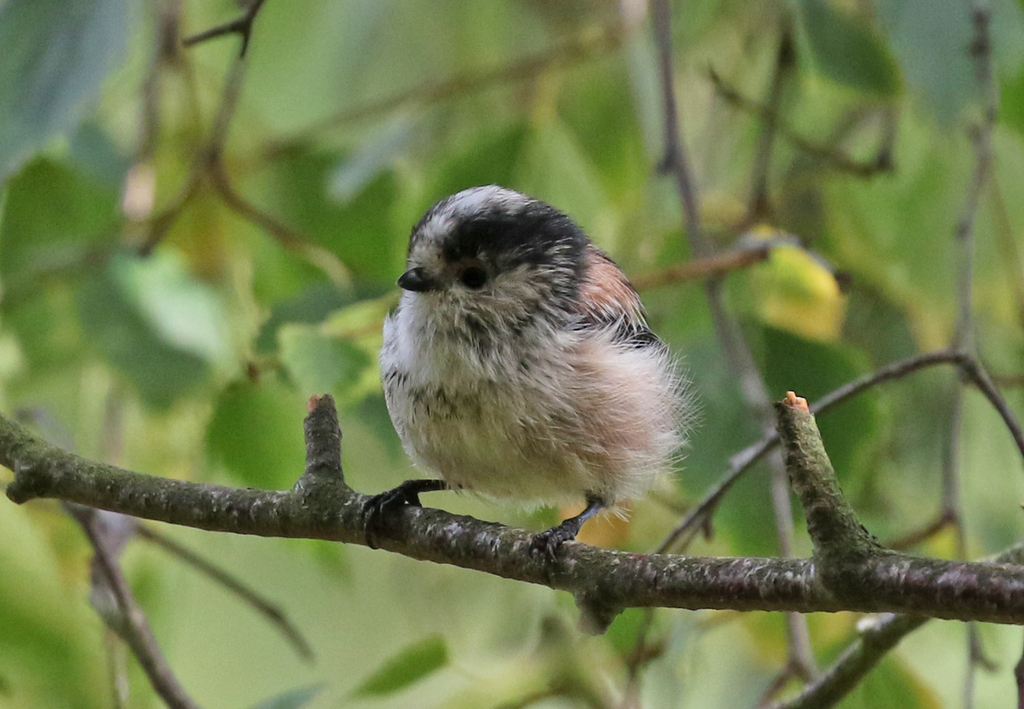
As well as the Long-tailed Tits, there were Blue and Great Tits and several Coal Tits, feeding actively in the trees all around us. A couple of Goldcrests flitted around in the branches of the big old pine tree above us and higher up, a Treecreeper worked its way up the trunk. A Green Woodpecker called and flew past through the tops.
There were warblers with them, Chiffchaffs and Blackcaps. Then we caught a glimpse of a different warbler high up in one of the birch trees. It was greenish above with a yellow wash on its throat, and plain faced, lacking the distinct supercilium of the Chiffchaffs, with rather a beady dark eye as a result. It was a bit bigger too, and moved more heavily through the foliage.
The warbler kept disappearing into the leaves and a couple of times we thought it had possibly moved off, before it reappeared again. Gradually, over several minutes, we built up a composite picture of it. It had a distinct pale panel in the secondaries when we could see its wings and, viewed from underneath, it seemed to have a rather broad bill with an bright orange base. It was obviously one of the Hippolais warblers, with Icterine Warbler far and away the most likely here, particularly given the conditions. Unfortunately, they can be difficult to tell apart from the very similar Melodious Warbler and we just couldn’t the primary projection, the clinching identification criteria.
As the tit flock moved back through the trees away from us, the warbler did finally disappear. We thought it might have gone with the tits, so we set off after them. It was hard to see the birds deep in the birches but eventually the flock came out onto the edge of the main track. Unfortunately, we couldn’t see the warbler with them. Frustrating!
Rather than waste the whole day trying to find it again, we decided to move on and drove round to Holkham. As we drove up Lady Anne’s Drive, a large flock of Pink-footed Geese was circling round over the grazing marshes and as we got out they whiffled down and disappeared from view.
We made our way west along the track on the inland side of the pines and it wasn’t far before we found another tit flock. We had good views of another Treecreeper climbing up the trunk of one of the pines, but we couldn’t see anything different in with them before they disappeared into the trees. Carrying on, there were several Little Grebes on Salts Hole and a Kestrel hovering over the grazing marshes beyond.

We walked up the boardwalk behind Washington Hide. This can be a good area for migrants, but the only bird we could find in the sycamores was a single Chiffchaff. There was more activity on the pool in front of the hide – as we walked round on the boardwalk we spotted a Great White Egret standing on the post in the middle of the pool, preening. We got the scope on it and had a look, admiring its long, dagger-shaped yellow orange bill, as a Grey Heron walked past below for a good size comparison. Then it was pushed off by a Cormorant which decided it was a good place to dry its wings.
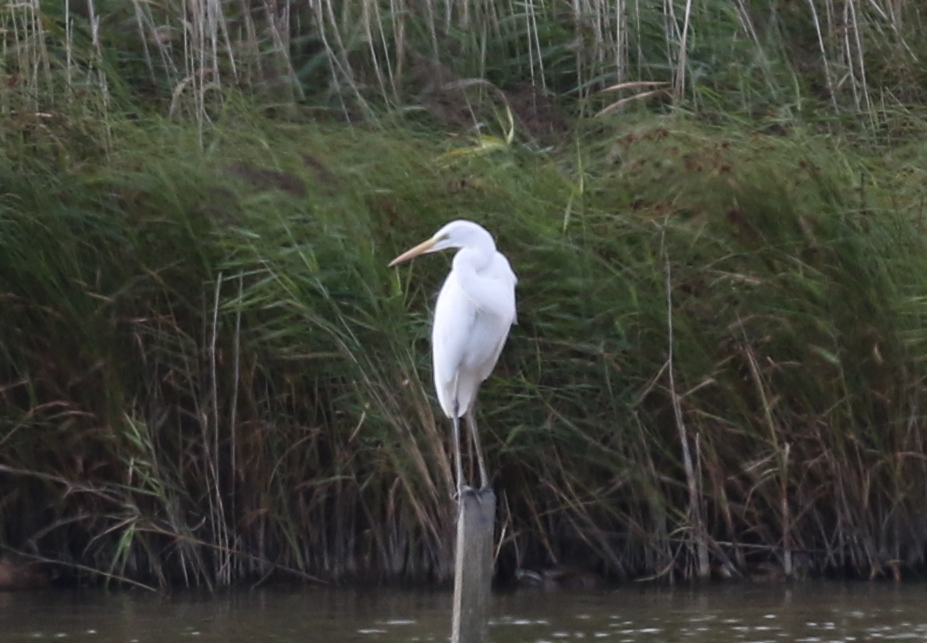
There were three other large white birds around the edges of the pool, which were three Spoonbills. We watched as they worked their way in and out of the reeds, sweeping their bills from side to side in the shallows.
Carrying on along the path, we headed for Joe Jordan hide. The trees behind Meals House were very quiet too – it seemed like we might be out of luck trying to find any migrants here. Then just before we got to the crosstracks, we heard the distinctive call of a Pied Flycatcher in the trees. It flicked across the path in front of us into a large oak tree, where we managed to get a few glimpses of it. Then it disappeared out the back.
We walked slowly along the track, and could hear the Pied Flycatcher calling again in a large hawthorn beside the path ahead of us. Just as we tried to position ourselves to see it, a second Pied Flycatcher flicked up in the small oak right beside us. It shot across the path but when we tried to follow it, we lost track of it. Then we turned round and it was back in the small oak tree again. We were in a better position now and we stood back and had a great view of it when it flicked out and landed on the outside of the tree.
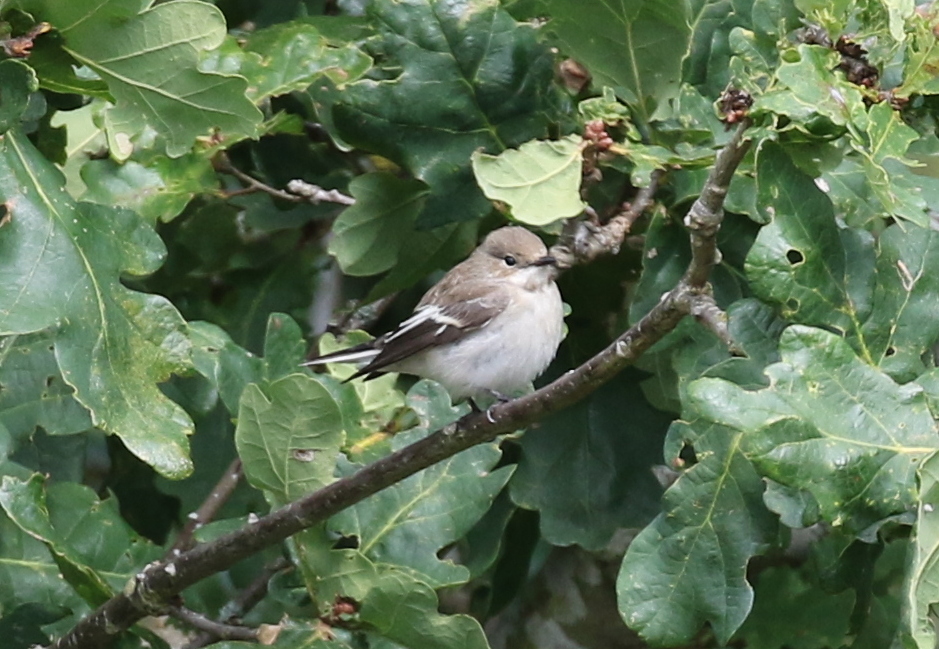
We could still hear a Pied Flycatcher calling from deeper in the trees, and then the second bird appeared in the small oak too. But when we looked at it, it wasn’t calling and the sound was still coming from further back. There were actually at least three here! Pied Flycatchers are migrants here, passing through on their way from Scandinavia south for the winter. There had obviously been a small fall of them on the coast today.
We had a quick look out at the grazing marshes from up in Joe Jordan Hide. We could see lots of Pink-footed Geese down in the grass from here. A Sparrowhawk came out of the trees and circled out over the grass. It flushed a big flock of Meadow Pipits which circled up above it, determined to keep it below them where they could see it! A Common Buzzard was perched on the scaffold tower out in the middle and a Kestrel flew across in front of the hide with something in its talons.
We decided to set off back, so we wouldn’t be too late for lunch. With the sun out, it was very warm now out of the wind in the lee of the trees. There were lots of dragonflies – Common and Ruddy Darters which flushed from the bushes by the track as we passed, and clouds of Migrant Hawkers zipping back and forth on the edge of the trees.

After lunch back at the Lookout Cafe, we set off back east. We were aiming to finish the day at Stiffkey, but we still had a little extra time available so we called in at Wells again. We had stopped to check out the pools here on our first morning, but had not managed to look around the bushes as it started to rain, so we thought we would try again now.
As we got out of the minibus, we could see a Great White Egret working its way along the back edge of the pools on the left of the track, our second of the day. We had a look at it in the scope, before it disappeared from view behind the vegetation. A Green Sandpiper, a Common Redshank and two Common Snipe were on the pools this side too.
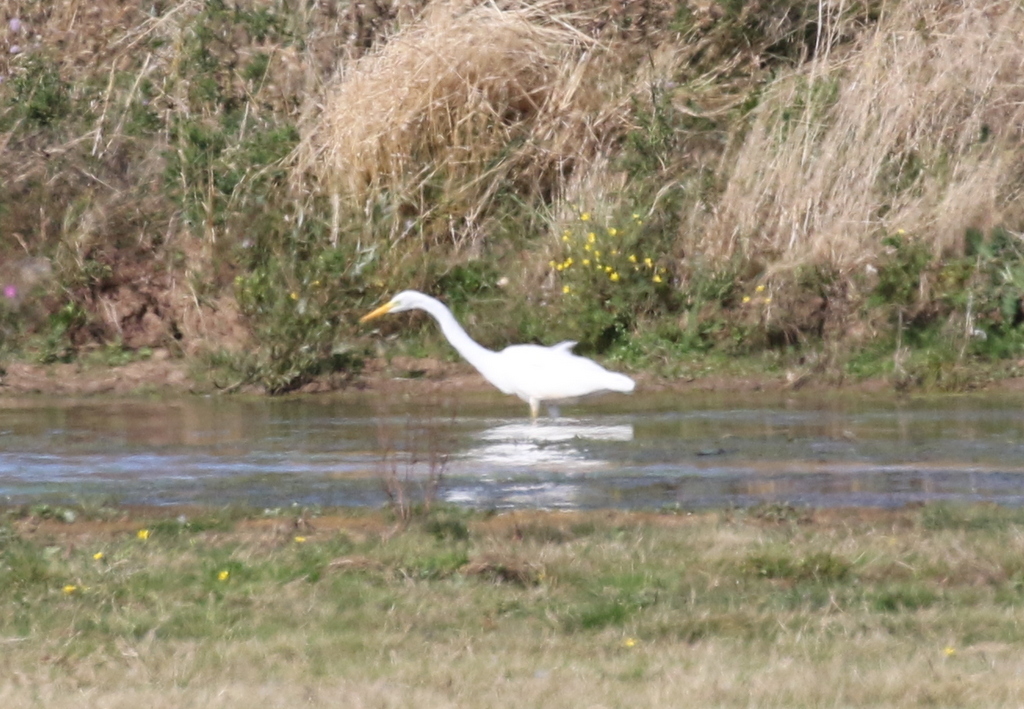
We set off down the track. There were a few more Pink-footed Geese with the Greylags and Egyptian Geese today, presumably more birds arriving back from Iceland, but no sign of any Barnacles. There had apparently been some Pintail here this morning, but despite scanning through the ducks carefully, we couldn’t find any. There was no sign of the Garganey either, but lots of the ducks were asleep in the grass at the back.
There were lots of Black-tailed Godwits on the pools and more Ruff today. A large flock of Black-tailed Godwits was wheeling round over the stubble field beyond, but we couldn’t see why. A juvenile Curlew Sandpiper was feeding on the mud with five Dunlin, a bit distant in the heat haze but nice to see one to keep up our unbroken record across each of the three days! We could hear Greenshank calling and when we got to the far side, we looked back to see four on the mud behind the vegetation along the far edge.
As we got to the bushes beyond the pools, we could hear a soft tacking call, more of a ‘tsk’ than a hard ‘tack’, and as we turned to watch a Lesser Whitethroat came out of the leaves and started to feed on the blackberries. It was grey-brown on the back, with a soft grey head, slightly darker mask and bright white throat and underparts.
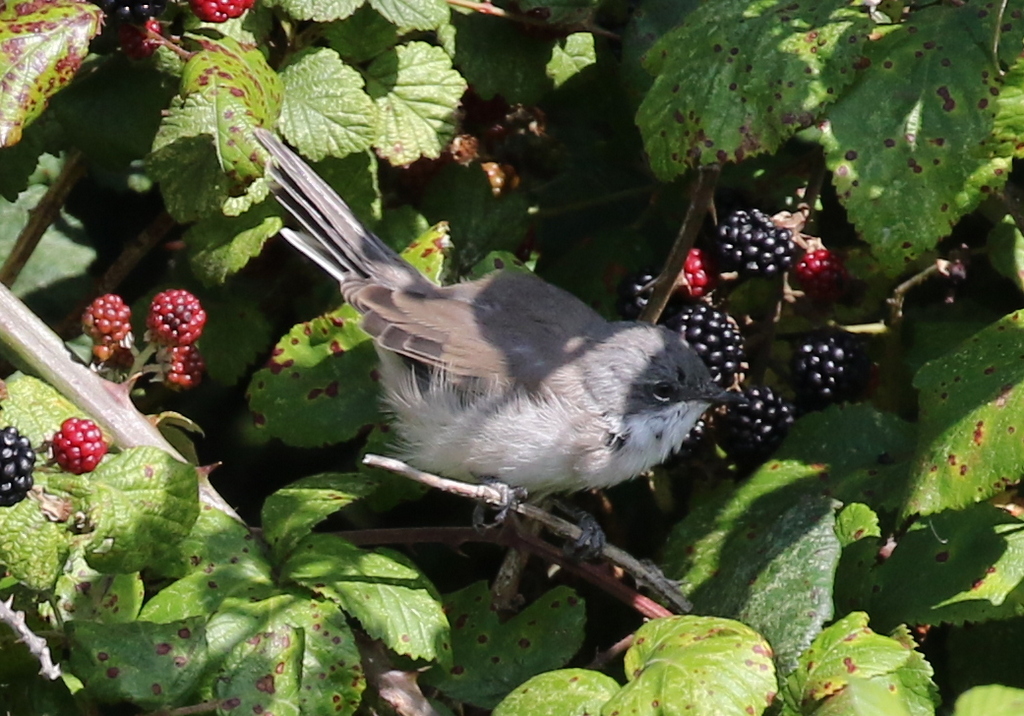
As we carried on round through the bushes, we found at least two more Lesser Whitethroats. A Common Whitethroat flew across and landed on the top of some low brambles briefly and we heard one or two Blackcaps calling, a distinctly harder ‘tack’ than the Lesser Whitethroat. There were Goldfinches and one or two Greenfinches in the bushes too, as well as a few Reed Buntings and a Yellowhammer which flew off towards the fields beyond.
Our last stop was at Stiffkey Fen. The permissive path between the hedges on the verge is too overgrown to walk down, so we had to make our way carefully along the road today, until we got to the footpath down by the river. A cacophony of shooting started up over the fields inland – with the close season now, presumably it was some sort of clay pigeon shooting event. There were a few House Martins still circling round the house on the hill, but there was not much to see in the bushes along the path this afternoon.
As we got to the point where the brambles are low enough to see over the Fen, we realised something was wrong. The islands were half empty, and the geese were walking nervously away from the side nearest the road, honking. Five duck flew up and disappeared off, three Pintail leading, followed by a pair of Wigeon. There should have been around 35 Spoonbills on here, but we could only see two.

From up on the seawall, we could see that the noise of all the shooting had scared almost everything off. We could still see the two Spoonbills in with all the Greylags, but there were no ducks at all. The island at the back, closest to the noise and which is normally packed with roosting birds, was completely empty. There were very few waders on the Fen either – just three Greenshank (joined briefly by a fourth) and much fewer Black-tailed Godwits, Redshanks and Ruff than normal. We did manage to find a single Green Sandpiper along the far shore. All in all, very disappointing.
We decided to walk round to the harbour. There were still a few people and boats around, enjoying the sunshine, but there was a lot less disturbance here than last week. The Spoonbills were out on the saltmarsh. They were rather distant and hard to count, with some hidden in the vegetation and quite a bit of heat haze now, but we could see at least 25 here. The two which were left on the Fen flew overhead and out to join the others. Numbers have already started to drop in the last few days, and it won’t be long now before they have left us, heading down to the south coast for the winter.
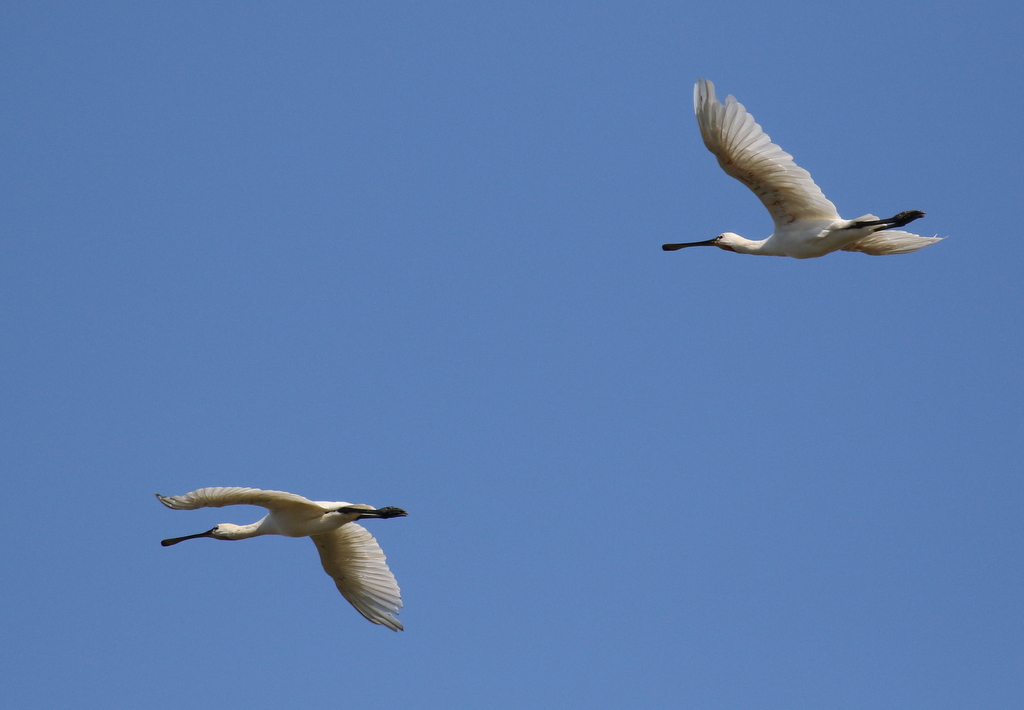
It was just after high tide, and there were lots of gulls roosting on the mud on the edge of the harbour. In with them, we found a few waders – several Ringed Plovers, a few Black-tailed Godwit and a Turnstone. A flock of Redshank flew in and landed in the shallow water behind them. A large mob of teenage Mute Swans was in the water further along and on the sandbank beyond them we could see more waders – a large roost of Oystercatchers, lots of godwits and a few Grey Plover, still sporting their summer black faces and bellies.
The surprise of the afternoon was a summer plumage Red-throated Diver swimming in the harbour, just off one of the spits of mud out in front of us. Presumably it had come into the harbour to get away from the choppy sea in all the wind yesterday. Its red throat was hard to see, but we could see its grey head, dark back and uptilted bill.
When a little flock of small waders shot across over the harbour, we looked up to see a distant falcon heading straight in towards us. It was clearly in a long stoop, coming very fast, but we couldn’t make out what it was at first, head on. When it got almost to the near shore, it changed its angle and dropped quickly down. It turned sharply and we watched as it chased after a small wader which had taken off from the mud and was trying to fly away over the water. It was now clear what it was, a Hobby. The wader quickly got away, and the Hobby circled up over the water and drifted in towards us, before flying off west.

It was great to watch the Hobby in action and a lovely way to wrap up what had been an exciting three days of Autumn birding in Norfolk.
















